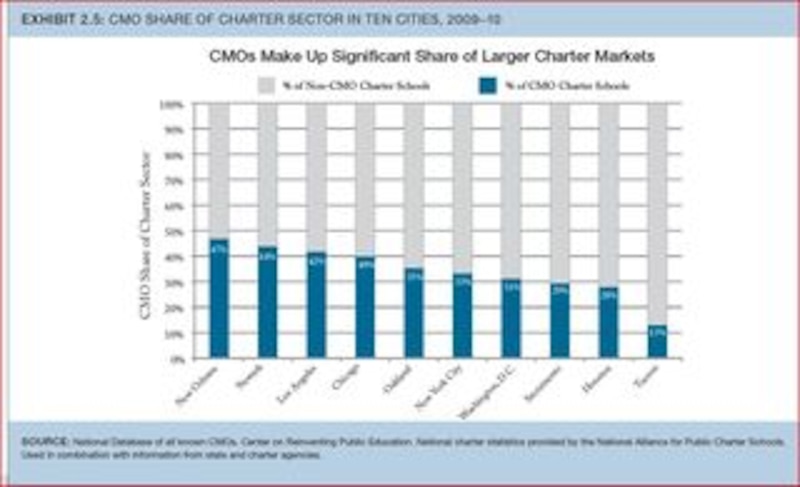A recent national study on Charter Management Organizations, or CMOs, by non-partisan Mathematica Policy Research, sheds some light on the role that these organizations play in the national educational landscape.
According to my own measures, CMOs ran 37 of the 77 charter schools in New York City during the 2008-2009 school year — and they have plans to open dozens more in the next decade. While CMOs attract large amounts of philanthropic support, anti-charter critics charge that they are opaque and run their schools more like for-profit institutions. This interim report offers fodder for both supporters and detractors. I found five points to be particularly interesting:
- CMOs need philanthropy to exist: All 44 CMOs in the study relied on philanthropic dollars to support operations. The average CMO relied on philanthropy for 13 percent of total operating revenues. CMOs funded by NewSchools Venture Fund report that 64 percent of their central office revenues come from philanthropy. The report concludes: “At least for now, these CMOs are unable to support their central offices (which often comprise 20% or more of total CMO spending) and facilities costs on per pupil revenues alone.”
- CMOs rely on alternate certification programs, like Teach For America, for talent: According to the report, almost 20 percent of teachers at CMO schools come from alternative certification programs like TFA. In addition, many of the people in managerial and leadership positions are TFA alumni. CMOs claim that teachers trained in the TFA mode are accustomed to longer hours and “No Excuses” approaches and therefore require less training in the culture of the CMO. The authors question the ability of CMOs to expand if they rely so heavily on one source of talent.
- CMOs have had problems expanding to high schools: Across the country, CMOs operate a disproportionate number of elementary and middle schools. CMO leaders say that expanding to high schools has proven difficult, both because the students arrive with an array of problems that the schools are ill-equipped to deal with and because “a highly prescriptive education model that works for middle school students may become a liability in high school… [S]tudents accustomed to highly structured courses can become too dependent on their instructors. If that happens, these students are unlikely to acquire the skills needed to navigate the more independent educational environment they will encounter in college.”
- CMO growth alone will not be able to improve entire school districts: Although CMOs have expanded rapidly, the recent pace of new CMO creation has slowed dramatically. The report notes that Arne Duncan’s goal of turning around the lowest performing 5,000 schools by 2014 can’t be reached by the current CMO crop alone, since these CMOs only plan on opening 336 new schools in that timeframe. Furthermore, the report points out that expanding often puts CMOs into shaky financial terrain: “Expansion may not equal sustainability: According to our survey, CMOs with two to six schools draw an average of 9.6% of their operating budgets from private funds. That proportion increases to an average of 14% for CMOs with seven to ten schools, and to 16.3% for CMOs with more than ten schools.”
- The majority of CMOs are clustered in five states and a handful of cities in those states: More than 80 percent of CMOs are clustered in a handful of places: California, Texas, Arizona, Ohio, Illinois, New York, and the District of Columbia. They make up a large share of big charter markets, but are relatively sparse in smaller markets. Furthermore, CMOs tend to open schools in regional markets—that is, there are very few CMOs that have national ambitions.

List of NYC CMOs counted in study:
Achievement First Beginning with Children Foundation – not included in survey because it had less than 3 charters open in 2007. Green Dot Harlem Children’s Zone – not included in survey because it had less than 3 charters open in 2007. Harlem Village Academies – not included in survey because it had less than 3 charters open in 2007. Lighthouse Academies Inc KIPP NYC St. Hope Uncommon Schools
Not included in study but included in my list (Most were not included in the Mathematica study because they had only one school open in 2008-2009):
Ascend Learning Inc Believe High School Network Boys and Girls Harbor Inc Explore Schools Inc Hyde Foundation Icahn Associates Corporation Public Prep Ross Institute Success Charter Network
About our First Person series:
First Person is where Chalkbeat features personal essays by educators, students, parents, and others trying to improve public education. Read our submission guidelines here.
